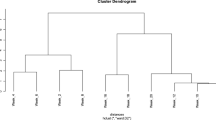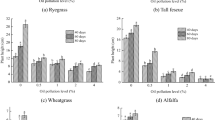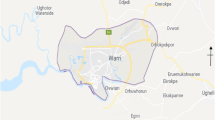Abstract
The aim of this study was to evaluate the spatial distribution of total petroleum hydrocarbons (TPH) in rhizoplane and non-rhizosphere of Leersia hexandra, known as Japanese grass, the effect of oil on the aerial biomass of L. hexandra, the population of plant growth-regulating bacteria, and microbial respiration in rhizosphere and non-rhizospheric soil. Samples of rhizosphere and soil were collected at 14 points across a surface of 2.3 ha, layer 1 (0–15-cm depth), layer 2 (15–30 cm), and layer 3 (30–70 cm), to measure TPH (mg kg−1). The spatial distribution of TPH defined four study zones (Z): Z1: 1393, Z2: 3455, Z3: 5574, and Z4: 7544. TPH were higher in underlying layers in the four zones. Zone 2 produced the largest amount of aerial biomass; oil induced hormesis in the grass, but inhibited it at doses ≥5574. For the rhizosphere of L. hexandra, it was cut with a sterilized knife, stimulated the population of N-fixing and phosphorus solubilizing, heterotrophic bacteria, as well as microbial respiration (day 1, 14, 21, 42, and 63 after incubation) in the four zones. The population of the three groups of bacteria was more stimulated by weathered oil in rhizosphere soil, compared to non-rhizosphere soil and with control treatment, suggesting that the rhizosphere system of L. hexandra has the potential to bioestimulate beneficial microbial activity in unpolluted and polluted areas compared to non-rhizosphere soil. We recommend the use of L. hexandra to recover soils degraded by weathered oil in farms located in the Mexican humid tropics.





Similar content being viewed by others
References
Abbasian, F., Lockington, R., Megharaj, M., & Naidu, R. (2016). The biodiversity changes in the microbial population of soils contaminated with crude oil. Current Microbiology, 72, 663–670.
Adenipekun, C. O., Oyetunji, O. J., & Kassim, L. S. (2009). Screening of Abelmoschus esculentus L. Moench for tolerance to spent engine oil. Journal of Applied Biosciences, 20, 1131–1137.
Alexander, M. (1994). Introducción a la Microbiología del Suelo. México, D.F. AGT Editor, S.A.
Amadi, A., Abbey, S. D., & Nma, A. (1996). Chronic effects of oil spill on soil properties and microflora of a rainforest ecosystem in Nigeria. Water, Air, and Soil Pollution, 86, 1–11.
Basumatary, B., Saikia, R., Bordoloi, S., Chandra, H. D., & Prasad, S. H. (2012). Assessment of potential plant species for phytoremediation of hydrocarbon contaminated areas of upper Assam, India. Journal of Chemical Technology and Biotechnology, 87, 1329–1334.
Björklöf, K., Salminen, J., Sainio, P., & Jørgensen, K. (2008). Degradation rates of aged petroleum hydrocarbons are likely to be mass transfer dependent in the Weld. Environmental Geochemistry and Health, 30, 101–107.
Bottomley, J. O., & Myrold, D. D. (2015). Biological N Inputs. In E. A. Paul (Ed.), Soil Microbiology Ecology, and Biochemistry. New York: Elsevier.
Brady, C. N., & Weil, R. R. (2008). The nature and properties of soil. New Jersey: Pearson Prentice Hall.
Brevik, E. C., Cerdá, A., Mataix-Solera, J., Pereg, L., Quinton, J. N., Six, J., & van Oost, K. (2015). Interdisciplinary nature of soil. The Soil, 1, 117–129.
Calabrese, E.J. (2012). Hormesis: improving predictions in the low-dose zone. In: A. Luch (Ed.), Molecular, Clinical and Environmental Toxicology. Experientia Supplementum 101, Springer Basel.
Camacho-Morales, R. L., Durón-Castellanos, A., Flores-Martínez, A., & Zazueta-Sandoval, R. (2010). Actividades dihidroxidiol-deshidrogenasa en Mucor circinelloides YR-1 aislada de suelo contaminado con petróleo. Acta Universitaria, 20, 45–50.
Chauhan, A., Oakeshott, J. G., & Jain, R. K. (2008). Bacterial metabolism of polycyclic aromatic strategies for bioremediation. Indian Journal of Microbiology, 48, 95–113.
de Farias, V., Maranho, L. T., de Vasconcelos, E. C., Carvalho, F. M. A. S., Lacerda, L. G., Azevedo, J. A. M., Pandey, A., & Soccol, C. R. (2009). Phytodegradation potential of Erythrina crista-galli L., Fabaceae, in petroleum-contaminated soil. Applied Biochemistry and Biotechnology, 157, 10–22.
García, A., & Rivero, C. (2008). Evaluación del carbono microbiano y la respiración basal en respuesta a la aplicación de lodo papelero en los suelos de la Cuenca del Lago de Valencia. Venezuela. Revista Facultad Agronomía. (Maracay), 34, 215–229.
Gaskin, S., & Bentham, R. (2010). Rhizoremediation of hydrocarbon-contaminated soil using Australian native grasses. Science of the Total Environment, 408, 3683–3688.
INEGI. (2001). Síntesis de Información Geográfica del Estado de Tabasco (1ath ed.). México: Instituto Nacional de Estadística y Geografía.
Jenkinson, D. C. (1976). The effects of biocidal treatments on metabolism in soil. IV. The decomposition of fumigated organisms in soil. Soil Biology and Biochemistry, 8, 203–208.
Jing, Y., He, Z., & Yang, X. (2008). Role of rhizobacteria in phytoremediation of heavy metal contaminated soils. Journal of Zhejiang University. Science. B, 8, 192–207.
Johnson, L. F., & Curl, E. A. (1972). Methods for research on the ecology of soil-borne plant pathogens. Minnepolis: Burgess Publishing Company.
Katznelson, H. (1946). The rhizosphere effect on mangels on certain groups of microorganisms. Soil Science, 62, 343–354.
Kechavarzi, C., Pettersson, K., Leeds-Harrison, P., Ritchie, L., & Ledin, S. (2007). Root establishment of perennial ryegrass (L. perenne) in diesel contaminated subsurface soil layers. Environmental Pollution, 145, 68–74.
Kertesz, A. M., & Frossard, E. (2015). Biological cycling of inorganic nutrients and metals in soil and their role in soil biogeochemistry. In E. A. Paul (Ed.), Soil Microbiology Ecology, and Biochemistry. New York: Elsevier.
Kirk, L. J., Klironomos, N. J., Lee, H., & Trevors, T. J. (2005). The effects of perennial ryegrass and alfalfa on microbial abundance and diversity in petroleum contaminated soil. Environmental Pollution, 133, 455–465.
Li, X., Feng, Y., & Sawatsky, N. (1997). Importance of soil water-relations in assessing the endpoint of bioremediated soils: plant growth. Plant and Soil, 192, 219–226.
Liao, C., Liang, X., Lu, G., Thai, T., Xu, W., & Dang, Z. (2015). Effect of surfactant amendment to PAHs-contaminated soil for phytoremediation by maize (zea mays L.). Ecotoxicology and Environmental Safety, 112, 1–6.
Liu, J., Duan, C., Zhang, X., Zhu, Y., & Lu, X. (2011). Potential of Leersia hexandra Swartz for phytoextraction of Cr from soil. Journal of Hazardous Materials, 188, 85–91.
Liu, X., Li, X., Chermaine, O., & Chu, Z. (2013). Progress of phytoremediation: focus on new plant and molecular mechanism. Journal of Plant Biology and Soil Health, 1, 1–5.
Liu, J., Zhang, X., You, S., & Zhou, K. (2015). Function of Leersia hexandra Swartz in constructed wetlands for Cr (VI) decontamination: a comparative study of planted and unplanted mesocosms. Ecological Engineering, 81, 70–75.
Madigan, M.T., Martinko, J.M., Dunlap, P.V., & Clark, D.P. (2009). Brock. Biología de los Microorganismos. 12a. ed. Madrid, Esp. Pearson Educación, S.A.
Maldonado-Chávez, E., Rivera-Cruz, M. C., Izquierdo-Reyes, F., & Palma-López, D. J. (2010). Efecto de rizosfera, microorganismos y fertilización en la biorremediación y fitorremediación de suelos con petróleos crudo nuevo e intemperizado. Universidad y Ciencia Trópico Húmedo, 26, 121–136.
Maletic, S. P., Dalmacija, B. D., Roncevic, S. D., Agbaba, J. R., & Ugarcina, P. (2011). Impact of hydrocarbon type, concentration and weathering on its biodegadability in soil. Journal of Environmental Science and Health, Part A, 46, 1042–1049.
McGill, W. B. (2007). The physiology and biochemistry of soil organisms. In E. A. Paul (Ed.), Soil microbiology, ecology, and biochemistry. Amsterdam: Elsevier.
Mehrasbi, M. R., Haghighi, B., Shariat, M., Naseri, S., & Naddafi, K. (2003). Biodegradation of petroleum hydrocarbons in soil. Iranian Journal of Public Health, 32, 28–32.
Merkl, N., Schultze-Kraft, R., & Infante, C. (2005). Assessment of tropical grasses and legumes for phytoremediation of petroleum-contaminated soils. Water, Air, and Soil Pollution, 165, 195–209.
Miranda-Martínez, M. R., Delgadillo-Martínez, J., Alarcón, A., & Ferrera-Cerrato, R. (2007). Degradación de fenantreno por microorganismos en la rizosfera del pasto alemán. Terra Latinoamericana, 25, 25–33.
Mohsenzade, F., Nasseri, S., Mesdaghinia, A., Nabizadeh, R., Zafari, D., & Chehregani, A. (2009). Phytoremediation of petroleum-contaminated soils: pre-screening for suitable plants and rhizospheral fungi. Toxicological and Environmental Chemistry, 91, 1443–1453.
Muratova, Y. A., Dmitrieva, T. V., Panchenko, L. V., & Turkovskaya, V. O. (2008). Phytoremediation of oil-sludge-contaminated soil. International Journal of Phytoremediation, 10, 486–502.
Muratova, Y. A., Golubev, N. S., Dubrovskaya, V. E., Pozdnyakova, N. N., Panchenko, V. L., Pleshakova, V. E., Chernyshova, P. M., & Turkovskaya, V. O. (2012). Remediating abilities of different plant species grown in diesel-fuel-contaminated leached chernozem. Applied Soil Ecology, 56, 51–57.
Njoku, K. L., Akinola, M. O., & Taiwo, B. G. (2009). Effect of gasoline diesel fuel mixture on the germination and the growth of Vigna unguiculata (Cowpea). African Journal of Environmental Science and Technology, 3, 466–471.
Nogueira, L., Inckot, R., Santos, G., Sousa, L., & Bona, C. (2011). Phytotoxicity of petroleum contaminated soil and bioremediated soil on Allophylus edullis. Rodriguesia, 62, 459–466.
Ogbo, E. M. (2009). Effects of diesel fuel contamination on seed germination of four crop plants-Arachis hypogaea, Vigna unguiculata, Sorghum bicolor and Zea mays. African Journal of Biotechnology, 8, 250–253.
Olalekan, A. (2014). The effect of palm kernel oil (PKO) biodiesel-contaminated soil on morphological and biochemical properties of Zea mays. Journal of Plant Biochemistry and Physiology, 2, 138–143.
Omosun, G., Edeoga, H. O., & Markson, A. A. (2009). Anatomical changes due to crude oil pollution and its heavy metals component in three Mucuna species. Recent Research in Science and Tecnology, 1, 264–269.
Orozco-Soto, M., Gutiérrez-Rojas, M., & Peralta-Pérez, M. R. (2014). Efecto de la composición de una mezcla de hidrocarburos en la respuesta fenotípica y la acumulación de azúcares por Bouteloua curtipendula Michx. Torr. en cultivo in vitro. Polibotánica, 38, 159–172.
PEMEX (Petróleos Mexicanos). (1988). El Petróleo. México D.F.
Peralta-Pérez, M. R., & Volke-Sepúlveda, T. L. (2012). The antioxidant defense in plants: a key tool for phytoremediation. Revista Mexicana de Ingenieria Quimica, 11, 75–88.
Pikovskaya, R. I. (1948). Mobilization of phosphorus in soil in connection with their vital activities of some microbial species. Mikrobiologya, 17, 362–370.
Pothuluri, V. J., & Cerniglia, E. C. (1994). Microbial metabolism of polycyclic aromatic hydrocarbons. In R. G. Chaudry (Ed.), Biological degradation and bioremediation of toxic chemicals. Portland, Oregon: Dioscorides Press.
Pravecek, L. T., Christaman, F. R., & Pfaender, K. F. (2005). Impact of imposed anaerobic conditions and microbial activity on aqueous-phase solubility of polycyclic aromatic hydrocarbons from soil. Environmental Toxicology and Chemistry, 24, 286–293.
Rennie, R. J. (1981). A single medium for the isolation of acetylene reducing (dinitrogen-fixing) bacteria from soils. Canadian Journal of Microbiology, 27, 8–14.
Rivera-Cruz, M.C. (2011). Bacterias y hongos en suelos contaminado con petróleo crudo en Tabasco. In R.R. Gamboa (Eds.), Recursos Genéticos Microbianos en la Zona del Golfo-Sureste de México. Volumen 1. Subsistema Nacional de Recursos Genéricos Microbianos (Subnargem). SAGARPA, México, D.F.
Rivera-Cruz, M. C., Ferrera-Cerrato, R., Volke-Haller, V., Fernández-Linares, L., & Rodríguez-Vázquez, R. (2002). Poblaciones microbianas en perfiles de suelos afectados por hidrocarburos del petróleo en el estado de Tabasco, México. Agrociencia, 36, 149–160.
Rivera-Cruz, M. C., Ferrera-Cerrato, R., Sánchez-García, P., Volke-Haller, V., Fernández-Linares, L., & Rodríguez-Vázquez, R. (2004). Descontaminación de suelos con petróleo crudo mediante microorganismos autóctonos y pasto alemán [Echinochloa polystachya (H.B.K.) Hitchc.]. Agrociencia, 38, 1–12.
Rivera-Cruz, M. C., Trujillo-Narcía, A., Trujillo-Rivera, E. A., Arias-Trinidad, A., & Mendoza-López, M. R. (2016). Natural attenuation of weathered oil using aquatic plants in a farm in Southeast México. International Journal of Phytoremediation, 18, 877–884.
Riveroll-Larios, J., Escalante-Espinosa, E., Fócil-Monterrubio, R. L., & Díaz-Ramírez, I. J. (2015). Biological activity assessment in Mexican tropical soils with different hydrocarbon contamination histories. Water Air Soil and Pollution, 226, 353.
Rodríguez-Carrasquel, S. (1983). Pasto alemán, para Caribe, Tannagrass, paja de agua, lambedora y Chi Guirera. Revista de Difusión de Tecnología Agrícola y Pesquera del FONAIAP No.12. Septiembre-Octubre 1983. Instituto Nacional de investigaciones Agrícolas. Bolivia, Venezuela.
Rodríguez-Vázquez, R., Sánchez, S., Mena-Espino, X., & Amezcua-Allieri, M. A. (2016). Identification of the medicinal plant species with the potential for remediation of hydrocarbons contaminated soils. Acta Physiologiae Plantarum, 38, 23.
Saadoun, I., & Al-Ghazawi, Z. (2010). Toxicity of diesel fuel towards plant seeds as reflected by seed germination outcomes, sprout length and fresh weight. Journal Agriculture Environmental Science, 8, 167–172.
SAS (Statistical Analysis System). (2005). User´s Guide, Versión 9.1.3. SAS Institute, Inc. Cary, N.C.
SEMARNAT. (2002). Norma Oficial Mexicana NOM-021-RECNAT-2000. Que establece las especificaciones de fertilidad, salinidad y clasificación de suelos. Estudios, muestreo y análisis. México, D.F.
SEMARNAT. (2013). Norma Oficial Mexicana NOM-138-SEMARNAT/SSA1-2012. Límites Máximos Permisibles de Hidrocarburos en Suelos y Lineamientos para el Muestreo en la Caracterización y Especificaciones para la Remediación. México, D.F.
Shahsavari, E., Adetutu, M. E., & Anderson, A. P. (2013). Tolerance of selected plant species to petrogenic hydrocarbons and effect of plant rhizosphere on the microbial removal of hydrocarbons in contaminated soil. Water, Air, and Soil Pollution, 224, 1495.
Siddiqui, S., & Adams, W. A. (2002). The fate of diesel hydrocarbons in soils and their effect on the germination of perennial ryegrass. Environmental Toxicology, 17, 49–62.
Tadeo, F.R. (2000). Fisiología de las plantas y el estrés. In J. Azcón-Bieto J. & M. Talón (Eds.), Fundamentos de Fisiología Vegetal. McGraw-Hill/Interamericana. Madrid, Esp.
Timmerman, M. D., Fuller, L. G., & Burton, D. L. (2003). The effects of a crude oil spill on microbiological indices of soil biological quality. Canadian Journal of Soil Science, 83, 173–181.
Trujillo-Narcía, A., Rivera-Cruz, M. C., Lagunes-Espinoza, L. C., Palma-López, D. J., Soto-Sánchez, S., & Ramírez-Valverde, G. (2012). Efecto de la restauración de un Fluvisol contaminado con petróleo crudo. Revista Internacional de Contaminación Ambiental, 28, 361–374.
Turgay, O. C., Erdogan, E. E., & Karaca, A. (2010). Effect of humic deposit (leonardite) on degradation of semi-volatile and heavy hydrocarbons and soil quality in crude-oil-contaminated soil. Environmental Monitoring and Assessment, 170, 45–58.
Uribe-Hernández, R., Oca-García, M. O., Amezcua-Allieri, J. A., Zermeño-Eguía, L., & Martínez-Martínez, V. E. (2012). Ecotoxicity assessment of weathered waste oil in a Mexican wetland. Journal of Petroleum Science Research, 1, 26–31.
USEPA-3540C. (1996). Soxhlet extraction organics. SW-846 test methods for evaluating solid waste physical/chemical methods. http://www.epa.gov/wastes/hazard/testmethods/sw846/pdfs/3540c.pdf. Accessed 20 June 2012
Vásquez-Luna, M., Montiel-Flores, A., Vásquez-Luna, D., & Herrera-Tenorio, M. F. (2011). Impacto del petróleo crudo en suelo sobre la microbiota de vida libre fijadora de Nitrógeno. Tropical and Subtropical Agroecosystems, 13, 511–523.
Vegetti, A. C. (2002). Caracterización de los sistemas de ramificación en especies de Oryzeae (Poaceae). Candollea, 57, 251–260.
Vessey, J. K. (2003). Plant growth promoting rhizobacteria as biofertilizers. Plant and Soil, 255, 571–586.
Wang, Y., Feng, J., Lin, Q., Lyu, X., Wang, X., & Wang, G. (2013). Effects of crude oil contamination on soil physical and chemical properties in Momoge wetland of China. Chinese Geographical Science, 23, 708–715.
Xiao-Dong, H., El-Alawi, Y., Penrose, M. D., Glick, R. B., & Greenberg, M. B. (2004). Responses of three grass species to creosote during phytoremediation. Environmental Pollution, 130, 453–463.
Acknowledgments
This study was financially supported by funds from the Colegio de Postgraduados en Ciencias Agrícolas. The first author thank the Consejo Nacional de Ciencia y Tecnología of México for the scholarship 304522. We appreciate all the facilities provided by the owner of the land. Gratefully, we acknowledge the valuable corrections reviewers.
Author information
Authors and Affiliations
Corresponding author
Rights and permissions
About this article
Cite this article
Rodríguez-Rodríguez, N., Rivera-Cruz, M.C., Trujillo-Narcía, A. et al. Spatial Distribution of Oil and Biostimulation Through the Rhizosphere of Leersia hexandra in Degraded Soil. Water Air Soil Pollut 227, 319 (2016). https://doi.org/10.1007/s11270-016-3030-9
Received:
Accepted:
Published:
DOI: https://doi.org/10.1007/s11270-016-3030-9




